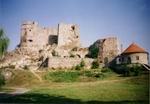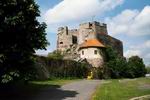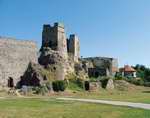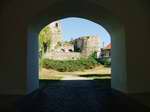Levice castle castle, ruin
A preserved ruin of a 13th-century Gothic castle, built on a rocky elevation to defend the southern approach to the central Slovak mining towns. Some of the preserved buildings today serve as the Tekov Museum and a cultural space.

Historic names
Levice; 1313 Leva, 1321 castrum Lewa
Description
The castle was built at the turn of the 13th and 14th centuries, likely in connection with the demise of the wooden-earth castle in Starý Tekov. The Levice Castle took over the defensive role and became the new county seat of Tekov. The oldest part of the castle, a single-wing palace of the upper castle, dates from this period. The first written mention of the castle is from 1318, when it was owned by Matúš Čák Trenčiansky. From 1388 to 1553, the castle was owned by the Levický family, who built a new two- or three-story rectangular palace, known as the middle castle. In the 16th and 17th centuries, extensive construction modifications were carried out due to the Turkish threat in the Renaissance style. Access to the castle courtyard was from the south side through a gate with a drawbridge, which is still preserved today. Later, the Dobó Manor House was added to the west, with a preserved Latin inscription indicating its completion in 1571. Despite the construction modifications, the castle capitulated to the Turks on November 2, 1663, and Levice became part of the Ottoman Empire for less than a year. The Turks were defeated by the imperial army led by Louis Rattuit de Souches on July 19, 1664, in the Battle of Levice. The anti-Habsburg uprisings at the beginning of the 18th century halted the development of the town after the departure of the Turks. The castle was occupied by the Kurucs in 1703, and their retreating army destroyed it in 1709. During the 18th and 19th centuries, the castle became a ruin and was never fully restored. Archaeological research was conducted in 1970-1972 (mainly the western palace, Zoltán Drenko) and 1983 (middle castle, Margaréta Pölhös). The castle received significant attention from the Schoeller family from 1867 until the end of World War II. The castle complex became the seat of a museum in 1958, and the central museum building was reconstructed from 1982 to 1998. Today, the castle houses a permanent exhibition, the Jozef Nécsey Gallery, an exhibition room, the directorate, depositories, staff offices, and a concert hall. The Dobó Manor House is open to the public as an exhibition and cultural-educational room. In the 19th and 20th centuries, it was owned by the Schoeller family, who also financed partial reconstruction of the castle and its surroundings. From this period comes the superstructure of the medieval defensive tower, known as the rotunda. Since 1958, the castle complex has been the seat of a museum. In the 1980s, the reconstruction of the central museum building, known as the Captain's Building, and the adjacent western bastion began. The reconstruction took place from 1982 to 1998, and in 2001, the first part of the permanent exhibition was opened. Today, these buildings house an expanded permanent exhibition, the Jozef Nécsey Gallery, an exhibition room, the directorate, depositories, staff offices, and a concert hall. This hall hosts puppet and theater performances, various conferences, and professional seminars. The Dobó Manor House is open to the public as an exhibition room and also a cultural-educational room, mainly used during events organized by the museum. Other parts of the Renaissance manor house contain depositories, a cultural-educational room, and conservation workshops. In the area of the southern bastion, there was a building that served as the seat of the Tekov Observatory from 1964 to 1981. In 1971, an observatory with a retractable roof was built here. However, due to damaged statics, this building was later demolished. Today, an amphitheater stands in the place of the southern bastion, built in 2005-2006. This amphitheater hosts various concerts and theater performances.
Location N48.221560,E18.601053
How to get here
From the railway or the bus station Levice:
From the station by L. Stur street to the city center Turn left to Sv. Michal street.





